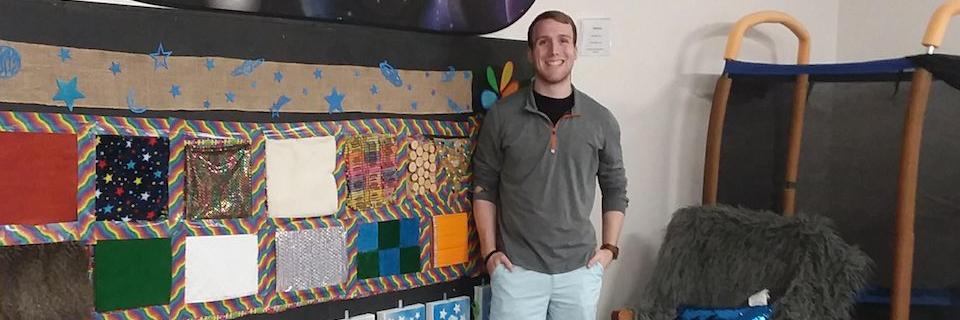For Future OT, Setting Up Sensory Room is a Dream Internship

Call it playing with a purpose — a bright, inviting room, with walls covered in swatches of all colors and textures. There’s also a small trampoline, fidget spinners, and a particularly comfy-looking blanket, to name a few. For a child, this looks like a dream come true.
When Rockhurst University junior Joey McGuire looks at the same space, he sees that and so much more. This summer, McGuire helped turn a bare room at a church in Great Falls, Montana, into a sensory room built for children with a range of special needs.
For McGuire, a psychology major who has planned to become an occupational therapist since sitting in on his younger brothers’ appointments, it was something of a dream come true, and an opportunity that almost didn’t happen at all. When the summer started, McGuire said he had an internship with an OT unit at a hospital in his hometown of Great Falls, and landed a caregiver position with Peace Place, a small respite care facility for children with special needs housed in a local church. The first week on the job, the church offered Peace Place an additional room for its exclusive use.
“The first thing that popped into my head was a sensory room,” and became the summer intern for the project, McGuire said.
As a smaller community, Great Falls doesn’t have the occupational therapy resources —in terms of providers or facilities — that a larger city might have. So a sensory room had the opportunity to make a big impact for children — and parents — in the community.
McGuire started by researching what other school systems, therapy centers, and other practitioners had done in their own sensory rooms.
“I literally sat down with a piece of paper and started thinking,” he said. “There are so many ideas out there already, and if you can be creative, there’s almost endless possibilities.”
With the help of a number of grants, McGuire and his mentor, occupational therapist Ashley Williams, were able to set up much of what was in that original plan, the centerpiece of which is the sensory wall — an array of squares with different colors, different textures, and different pictures, designed to engage, stimulate certain responses from or calm patients as needed. But alongside that resource is an array of things like a squeeze machine that provides therapeutic deep pressure, a swing for helping with balance and a trampoline to help with proprioception, or the “sixth sense” of knowing where one’s body is in space.
The process of acquiring the equipment and setting up the room took most of the summer, but McGuire said he was thankful to be able to see the equipment in action toward the end of his internship.
“To see a patient’s face as they start to realize what this all is, is so cool,” he said. “There were kids who would come in who had limited verbal function, and they would get on that trampoline and start saying ‘jump’ over and over again. That made the work feel so meaningful.”







